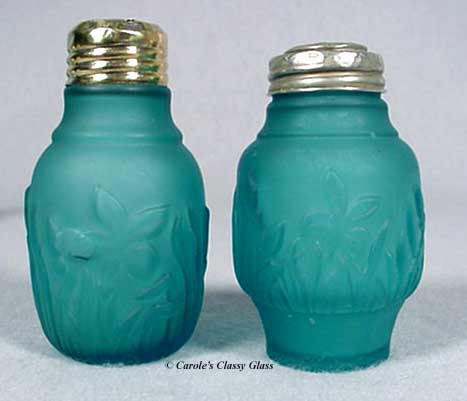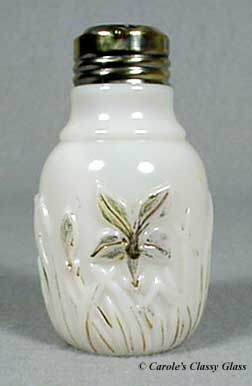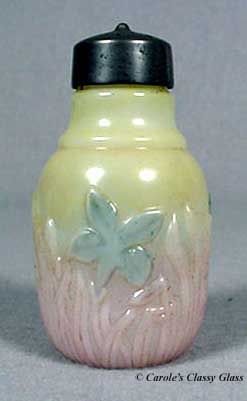Wild Iris – Pattern/Manufacturer Affirmation
Note: The following article, originally titled “Unreported Color in Wild Iris Salt Shaker Helps Link to Manufacturer: Dithridge,” appeared in the AGSSSC website several years ago. Your current webmaster chose to place the article in this “Research Articles” section to show the thinking and then current evidence glass researchers use to come to, approach, or waver on attribution of a glass pattern to its manufacturer. This note then serves to add another step, and probably final step, to the “Wild Iris attribution.” In a recent publication by Brad Gougeon, “Milk Glass/Pattern Glass, Book 1, The Blown Molded Patterns”, reproductions of a 1901 Consolidated Lamp and Glass catalog from the collection of The Rakow Research Library, The Corning Museum of Glass, show many pieces of the “Iris Tableware – Decorated” line and an accompanying price list. The decoration on these pieces is like the pink and yellow with blue flowers salt shaker pictured below. Brad also shows his own pictures of a small pitcher and a butter dish cover in the same teal blue as the shakers pictured above. The small pitcher and the butter dish cover have the same molded pattern as like pieces in the aforementoned trade ad. Also part of The Rakow collection is a Consolidated trade ad from “House Furnishing Review,” March 1897, picturing several table pieces including salt and pepper shakers (stand alone and in a three-piece condiment holder). Although there is no documentation of the rare blue being attributed to Consolidated, the uniqueness of the pattern itself and the ad’s reference to availability of the pieces in “crystal, opal and colors; with gold, lustre, enamel and natural color decorations” speaks for the attribution’s authenticity.
Now, read the original article:
 A member reported a recent purchase of a known shaker in a rare color in the stand alone version (pictured above with a like shaker made for a condiment set). This shaker was originally named Water Lily by Warman. Peterson changed it to Wild Iris. Then the Lechners named it Marsh Flower in their Book I, perhaps not recognizing that the Peterson shape was a condiment salt and the one they pictured was a stand alone salt. In their Book II they showed a condiment set and retained the original Peterson name of Wild Iris. Heacock endorsed the name Wild Iris with other pieces of the pattern. The Lechners attributed this shaker to Dithridge. No source of this attribution is given. Reports have been that an old Dithridge catalog shows this attribution. As a result, Bob Bruce compared the teal shaker to some known Dithridge shakers for color match. He also found an old article that Bill Heacock had written for the Antique Trader weekly in 1981.
A member reported a recent purchase of a known shaker in a rare color in the stand alone version (pictured above with a like shaker made for a condiment set). This shaker was originally named Water Lily by Warman. Peterson changed it to Wild Iris. Then the Lechners named it Marsh Flower in their Book I, perhaps not recognizing that the Peterson shape was a condiment salt and the one they pictured was a stand alone salt. In their Book II they showed a condiment set and retained the original Peterson name of Wild Iris. Heacock endorsed the name Wild Iris with other pieces of the pattern. The Lechners attributed this shaker to Dithridge. No source of this attribution is given. Reports have been that an old Dithridge catalog shows this attribution. As a result, Bob Bruce compared the teal shaker to some known Dithridge shakers for color match. He also found an old article that Bill Heacock had written for the Antique Trader weekly in 1981.
Most of the information from the articles Heacock wrote were condensed and updated in his book, “Old Pattern Glass According to Heacock”. This one escaped. Heacock showed a complete table set in this color and called it “Peacock Blue”. He noted that a previous writer attributed Wild Iris to Westmoreland based upon a company catalog (around 1910) that she had. Heacock accepted that attribution although he had previously felt it was by Consolidated. He mentioned that there is considerable confusion caused by the article as the author also claimed that the popular Cosmos pattern was also made by Westmoreland. He assumed that the Cosmos pattern must have appeared in the same catalog. Other documentation shows a Cosmos minilamp in a Consolidated catalog.
Heacock also noted that the author claimed that this color matched a color for the pattern “Late Westmoreland”. Heacock pointed out that he had seen a Parlor Lamp by Consolidated that matches this color.
The bottom line of the discussion is that it seems one must assume that both companies made both Cosmos and Wild Iris (OMN Iris). But, who made what, and what colors, and what decorations, is pending further research. It is now clear why this article did not make his later book; he must not have had any further information.
Heacock also noted that he saw this “Peacock Blue” set around 1976 and had not seen another piece in that color. He reserved any publication on it as he heard that AA Imports had reproduced the pattern; a fact he no longer believed as he had seen no other pieces. The condiment shaker had been known in this color but the stand alone shaker has never been reported. Please see the Condiment Set section for pictures of the condiment sets in this pattern.

Stand Alone Shaker, White: Gold Decor

Condiment Shaker, White: Maroon & Green Decor

Stand Alone Shaker, Pink & Yellow: Blue Flowers
Comparison of the Rare Teal Color of Wild Iris Shaker with Known Dithridge Shakers:
These colors are very close – it would be hard to assume that a different maker made them. This is fairly strong evidence that Dithridge made the Wild Iris pattern.
We must now believe, due to the evidence in the “Note” above, that Consolidated made the Wild Iris pattern. And, due to the uniqueness of the pattern itself, and without further evidence to the contrary, it must be assumed that Consolidated also made those pattern pieces in teal blue.
